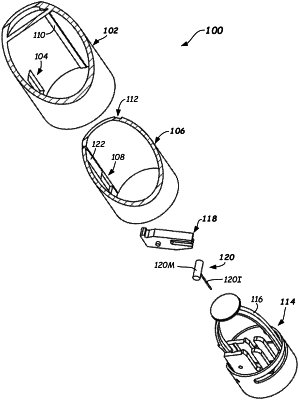| CPC A61B 17/3468 (2013.01) [A61B 5/1451 (2013.01); A61B 5/14532 (2013.01); A61B 17/3421 (2013.01); B29C 53/02 (2013.01); A61B 5/688 (2013.01); A61B 2017/00526 (2013.01); A61B 2017/347 (2013.01); A61B 2560/063 (2013.01); B29L 2031/752 (2013.01); B29L 2031/753 (2013.01)] | 25 Claims |

|
1. A continuous analyte monitoring inserter apparatus, comprising:
an outer member;
an inner member configured to slidably fit axially within the outer member;
a transmitter carrier configured to support a transmitter and biosensor assembly, the transmitter carrier comprising a bias member;
an insertion device; and
a pivot member configured to pivot relative to the transmitter carrier and support the insertion device,
wherein axial motion of the outer member is configured to press the bias member against the pivot member,
wherein over a first portion of a stroke, the bias member causes the pivot member to impart an axial movement to the transmitter carrier and the insertion device,
wherein over a second portion of the stroke, the bias member causes a pivot motion of the pivot member, and the pivot motion of the pivot member retracts the insertion device,
wherein the outer member comprises a first pivot window and the inner member comprises a second pivot window,
wherein at least a portion of the pivot motion of the pivot member occurs with the first pivot window of the outer member overlapping the second pivot window of the inner member, and
wherein during at least a portion of the pivot motion, an end portion of the pivot member enters the first pivot window by way of the second pivot window.
|